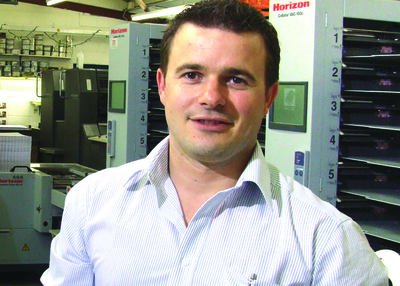Managing director, Alan Bunter
Packaging is not a sector that every digital print company will feel able to enter, but Remous has experience from its litho operations to call upon.
Dorset printer Remous has been printing packaging work on and off for around 20 years on its litho presses, but the investment in a Ricoh Pro C901 a couple of years ago opened up new opportunities in this and other markets.
‘We are now able to offer existing customers smaller runs,’ confirmed managing director Alan Bunter. ‘We’ve just done 1500 header cards across six different types: we printed them this morning, die cut them this afternoon and will despatch them tonight. We have the flexibility to say we can do just 250 and send that. Runs are getting shorter and shorter and people are trying to spend as little as possible on start up.’
He continued: ‘Most of the big packaging companies are not interested in doing 500 boxes, but we say our minimum run is one. It will be an expensive one, but we will quite merrily take on 50 boxes, which is no good if you’ve got a factory with a Bobst and lots of gluing lines.’ Remous is not set up this way, though it does have a cylinder and platen for die cutting. It has printed items such as side-seam glued boxes, crashlock boxes and header cards for years and the header cards are certainly one application that can translate to digital. Others are less likely to, given the constraints of the Ricoh’s SRA3 sheet.
‘There are not many small products that really enter your mind in packaging that you would think to put on a digital press. We have done pre-manufacture type things of a bigger job – doing samples to give the client up front. If you’re doing a business card box there’s no reason why you could not do that digitally if the press has good enough register, and I would say the Ricoh C901 does, as long as the paper is cut to the same size. It trips it up a bit if the paper from the mill is 320 mm but some sheets are 319 and some 321. Other than that, the register is good enough.’
Remous is putting 450 micron boardthrough the Ricoh press, which is the thickest it would put through to ensure a reliable result. A recent job was to print different header cards and barcodes for a tool manufacturer that has lots of different sizes of tool bits. There were about 100 different variants, with runs of 50 of one type, ten of another. ‘You could never have done that with litho,’ Mr Bunter observes.
He stresses the need for staff with the right skills however – something that not every commercial digital printer will necessarily already have. Remous is lucky in having one member of staff who has been involved with packaging jobs for one customer for a number of years. He is interested in the cardboard engineering aspect of packaging and understands the mechanics of side seam glued boxes and crashlock boxes.
‘The thought process behind it is a very specific one. That knowledge needs to be there, otherwise you will get yourself in a mess. It’s just experience really. Thinking and planning.
There’s a long thought process to how a box will work out. He creates a flatplan, goes to the die cutter, makes up a dummy and it gets checked and checked,’ said Mr Bunter.
He added that while Remous had not specifically invested in kit to digitally print packaging, it was important to have the die cutting and design knowledge. ‘The minute you have to farm out design and die cutting to someone there’s no point,’ he advised.
There is a small local market, but Remous’s packaging customers are located everywhere from Scotland down to Devon. The service is promoted through the company’s website, which brings in enquiries. Mostly it is a case of these customers finding Remous, rather than vice versa. ‘It’s very difficult to go and find new customers that have suitable packaging that you can produce competitively,’ he said.
There are no specific plans to ramp up the packaging aspect of the company’s business, although he said there is certainly scope to. Mr Bunter concluded: ‘It’s all down to time. We are trying to diversify to other parts of print and it all takes your attention away from it. The market is looking more spritely and the economy is on the up so we would hope there will be people launching new products and that they will come to us to get the first run done. The joy is that with both digital and litho we can take them from 50 boxes to 50,000.’





